Intel Dual Core Performance Preview Part I: First Encounter
by Anand Lal Shimpi on April 4, 2005 2:44 PM EST- Posted in
- CPUs
Business Application Performance
Business Winstone 2004
Business Winstone 2004 tests the following applications in various usage scenarios:- Microsoft Access 2002
- Microsoft Excel 2002
- Microsoft FrontPage 2002
- Microsoft Outlook 2002
- Microsoft PowerPoint 2002
- Microsoft Project 2002
- Microsoft Word 2002
- Norton AntiVirus Professional Edition 2003
- WinZip 8.1

There's no surprise here - your best business application performance is going to come from a very fast single core CPU.
Office Productivity SYSMark 2004
SYSMark's Office Productivity suite consists of three tests, the first of which is the Communication test. The Communication test consists of the following:"The user receives an email in Outlook 2002 that contains a collection of documents in a zip file. The user reviews his email and updates his calendar while VirusScan 7.0 scans the system. The corporate web site is viewed in Internet Explorer 6.0. Finally, Internet Explorer is used to look at samples of the web pages and documents created during the scenario."
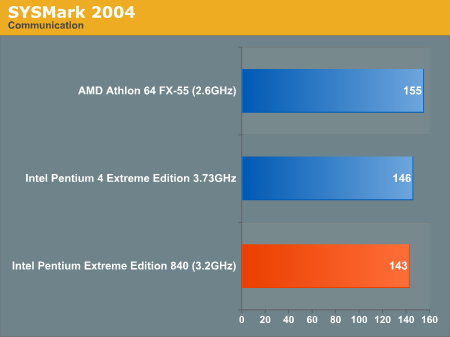
The next test is Document Creation performance:
"The user edits the document using Word 2002. He transcribes an audio file into a document using Dragon NaturallySpeaking 6. Once the document has all the necessary pieces in place, the user changes it into a portable format for easy and secure distribution using Acrobat 5.0.5. The user creates a marketing presentation in PowerPoint 2002 and adds elements to a slide show template."
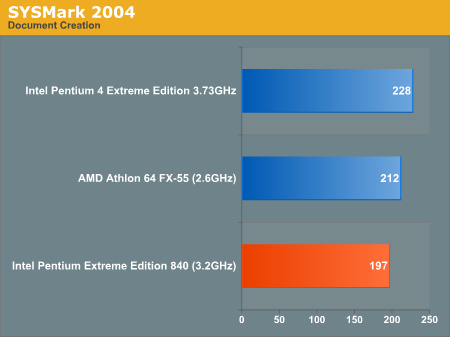
The final test in our Office Productivity suite is Data Analysis, which BAPCo describes as:
"The user opens a database using Access 2002 and runs some queries. A collection of documents are archived using WinZip 8.1. The queries' results are imported into a spreadsheet using Excel 2002 and are used to generate graphical charts."
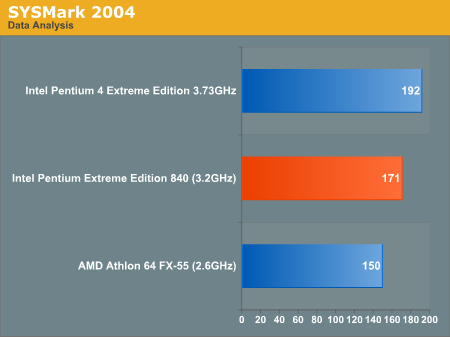
The Office Productivity SYSMark 2004 suite shows some benefit to dual core, given that there is quite a bit of multitasking involved in the test suite. Despite the multitasking, the Pentium Extreme Edition running at 3.2GHz isn't able to trounce its single core 3.73GHz relative.
Business Winstone 2004 includes a multitasking test as a part of its suite, which does the following:
"This test uses the same applications as the Business Winstone test, but runs some of them in the background. The test has three segments: in the first, files copy in the background while the script runs Microsoft Outlook and Internet Explorer in the foreground. The script waits for both foreground and background tasks to complete before starting the second segment. In that segment, Excel and Word operations run in the foreground while WinZip archives in the background. The script waits for both foreground and background tasks to complete before starting the third segment. In that segment, Norton AntiVirus runs a virus check in the background while Microsoft Excel, Microsoft Project, Microsoft Access, Microsoft PowerPoint, Microsoft FrontPage, and WinZip operations run in the foreground."
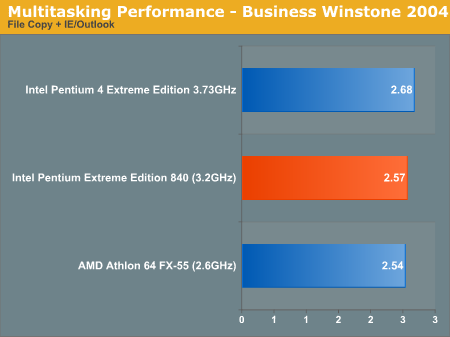
The performance of the dual core Extreme Edition comes within 5% of the 3.73GHz EE, despite the fact that the single core chip has a 16% clock speed advantage, but it is still slower overall.
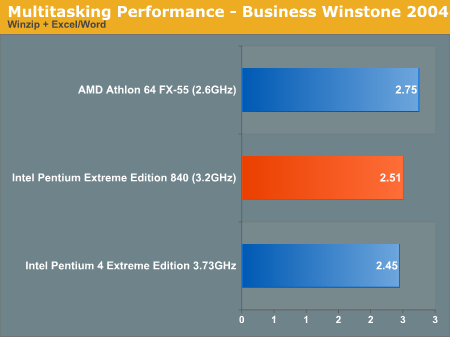
The second test finally shows something positive for the dual core chip, with a negligable 2% performance lead. This is the perfect example of how multi-core can be a substitute for clock speed when it comes to performance. Note that despite the Pentium Extreme Edition being faster than the 3.73EE, the single core Athlon 64 FX-55 is faster than both.
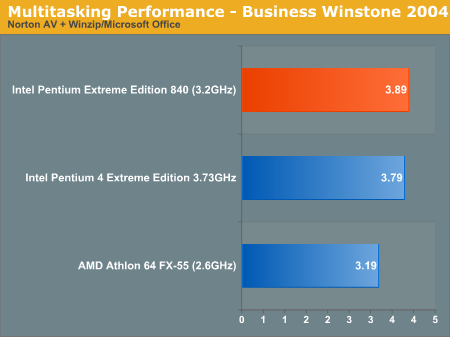
The third and final test also shows a slight performance advantage for the dual core Extreme Edition, even over the Athlon 64 FX-55.
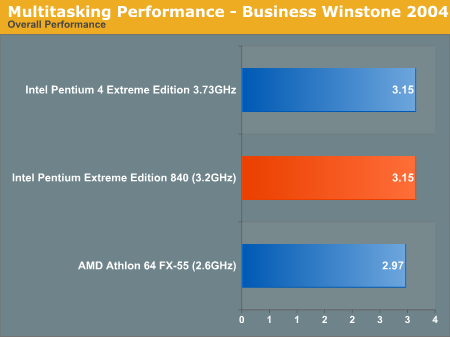










141 Comments
View All Comments
nserra - Tuesday, April 5, 2005 - link
Amd dualcore platform is right here today, the processor is not. And i dont see that a bad thing, upgradable as always been a good thing.#65 "Yes, same will also apply to the AMD's solution. Both CPU cores in dual core Opteron will share same bus and memory controller."
I am not really sure about that, amd always said the processor was being done dualcore since day one that must mean something. Dont forget that socket 939 is dual channel it could be possible to give one memory channel for one processor and the other channel for the other.
matthewfoley - Tuesday, April 5, 2005 - link
You people screaming for the gaming benchmarks, RTFA. Gaming or any other single threaded application will have identical results to a similarly clocked single core proc.ceefka - Tuesday, April 5, 2005 - link
#62 I read the article and think it's a rant, just a rant, no facts, just implications. I can sympathise with the feeling that Intel is let off the hook, for now.I do hope that games will be a substantial part of the benchies once the traditional AMD vs Intel dual core tournament takes place. Remember the pre-release benchies of the Opteron (that Italian thing)?
I also think that shrinking DVD's while typing in MS Word and listening to mp3 is about the maximum of things to do simultaneously. I have to get my head around it as well, you know ;-). It does however open a way to have someting like a home server or HTPC for everything but the most extreme stuff. It could record a TV-show, while watching a DVD and the wife chatting away on another screen.
Some say that dual core will have more benefit in servers because of the typical threaded applications. That's a good point. Can we look forward to a comparison of a 2 and 4-way dual core Opteron vs Xeon on typical server applications, workstation apps and maybe a few games just for fun.
smn198 - Tuesday, April 5, 2005 - link
lol @ #11 "now Intel is going to start eating AMD's lunch"Do you mean eating AMD for lunch? I think I prefer it your way.
RLandon - Tuesday, April 5, 2005 - link
The multitasking benchmarks clearly shows that Windows doesn't deserve to be refered to as an operating system.ceefka - Tuesday, April 5, 2005 - link
The price-difference between a dual and single core might not be too big on an Intel CPU, but you MUST get a new board. So the actual price difference when upgrading is $80 + brand new 955x motherboard. Nice one, Intel. A new board will cost you around $ 100 at least: actual difference $ 180. If AMD can stay under that difference they're at least competitive in pricing.Benchies are promising/impressive though. Wonder what the 64-bit benchies would be. Too bad that the introduction of dual-cores is in different segments (desktop vs server). Can't wait for some traditional Intel vs AMD benching ;)
#2
Read this article
http://www.anandtech.com/cpuchipsets/showdoc.aspx?... page 3, last paragraph.
AMD's Fred Weber finds Hyperthreading a "misuse of resources". AMD have always said two cores are better than a single core acting like one.
defter - Tuesday, April 5, 2005 - link
"INTEL's dual core isn't really dual-core, it's just two CPUs stick together"dual consisting of or involving two parts or components usually in pairs; "an egg with a double yolk"; "a double (binary) star"; "double doors"; "dual controls for pilot and copilot"; "duple (or double) time consists of two (or a multiple of two) beats to a measure": http://dict.die.net/dual/
Yes, two CPU stuck together can be called "dual core".
"the two cpus share the same bus, without any logic in between."
Yes, same will also apply to the AMD's solution. Both CPU cores in dual core Opteron will share same bus and memory controller.
IntelUser2000 - Tuesday, April 5, 2005 - link
130W isn't actually bad. The Xeon MP Potomac had TDP of 125W and max power of 136W, saying probably due to EIST, the difference is much less now. Plus, you aren't running two cores all the time, so if you are playing games only, then you would have 65W power consumption.Hmm... I wonder if the reason 1066MHz is not supported by any of the dual core processors is to dedicate more bandwidth of the Dual-DDRII-667 to integrated graphics. Or maybe we would see Yonah with 1066MHz bus as desktop?
IntelUser2000 - Tuesday, April 5, 2005 - link
falcc - Tuesday, April 5, 2005 - link
No games tested at all? Since when does this happen? Intel doesn't want dual core to look bad so Anandtech doesn't bench ANY games at all.Come on guys, judging by the article below on the Inquirer I'm not the only one who is suspicious.
http://theinquirer.net/?article=22332